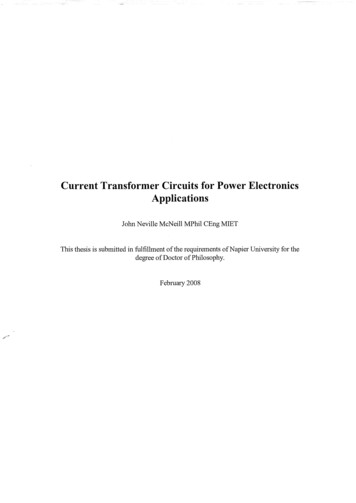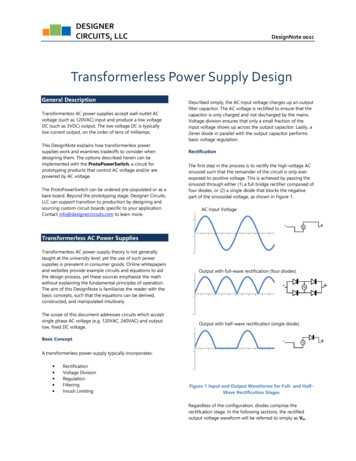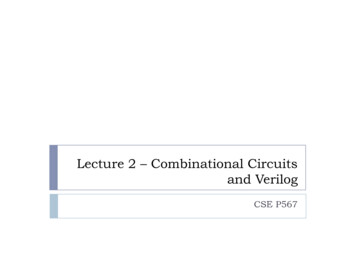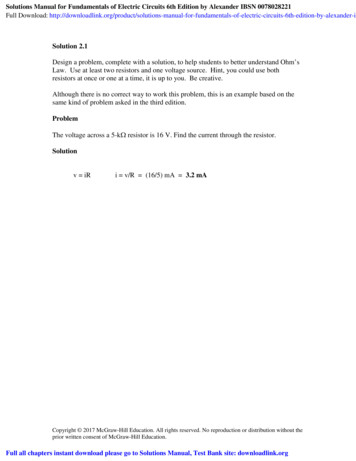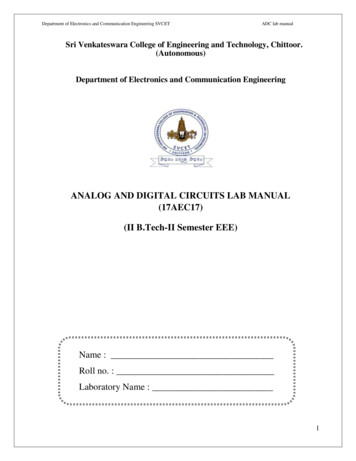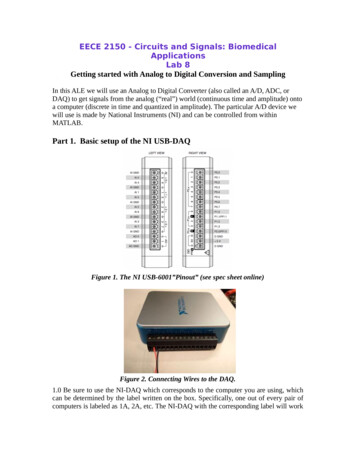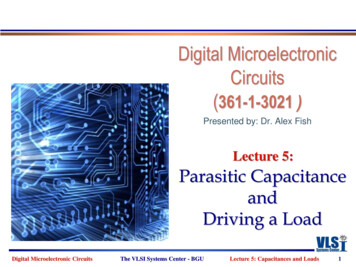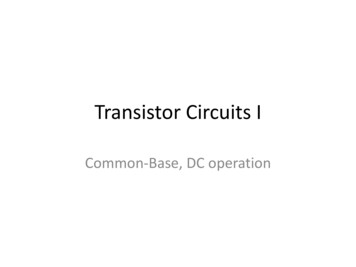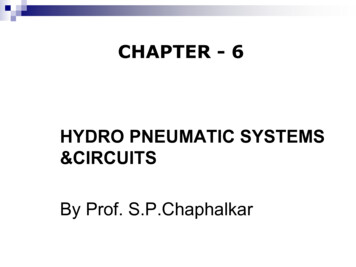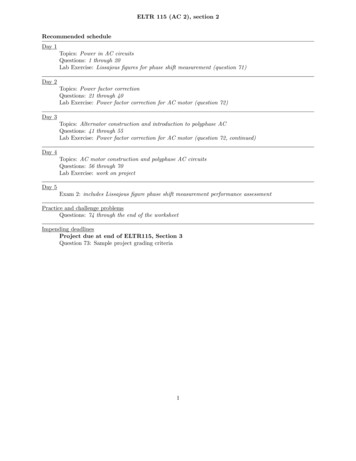
Transcription
ELTR 115 (AC 2), section 2Recommended scheduleDay 1Topics: Power in AC circuitsQuestions: 1 through 20Lab Exercise: Lissajous figures for phase shift measurement (question 71)Day 2Topics: Power factor correctionQuestions: 21 through 40Lab Exercise: Power factor correction for AC motor (question 72)Day 3Topics: Alternator construction and introduction to polyphase ACQuestions: 41 through 55Lab Exercise: Power factor correction for AC motor (question 72, continued)Day 4Topics: AC motor construction and polyphase AC circuitsQuestions: 56 through 70Lab Exercise: work on projectDay 5Exam 2: includes Lissajous figure phase shift measurement performance assessmentPractice and challenge problemsQuestions: 74 through the end of the worksheetImpending deadlinesProject due at end of ELTR115, Section 3Question 73: Sample project grading criteria1
ELTR 115 (AC 2), section 2Skill standards addressed by this course sectionEIA Raising the Standard; Electronics Technician Skills for Today and Tomorrow, June 1994CC.01C.04C.05C.30Technical Skills – AC circuitsDemonstrate an understanding of sources of electricity in AC circuits.Demonstrate an understanding of basic motor/generator theory and operation.Demonstrate an understanding of measurement of power in AC circuits.Understand principles and operations of AC polyphase circuits.B Basic and Practical Skills – Communicating on the JobB.01 Use effective written and other communication skills. Met by group discussion and completion of labwork.B.03 Employ appropriate skills for gathering and retaining information. Met by research and preparationprior to group discussion.B.04 Interpret written, graphic, and oral instructions. Met by completion of labwork.B.06 Use language appropriate to the situation. Met by group discussion and in explaining completed labwork.B.07 Participate in meetings in a positive and constructive manner. Met by group discussion.B.08 Use job-related terminology. Met by group discussion and in explaining completed labwork.B.10 Document work projects, procedures, tests, and equipment failures. Met by project construction and/ortroubleshooting assessments.C Basic and Practical Skills – Solving Problems and Critical ThinkingC.01 Identify the problem. Met by research and preparation prior to group discussion.C.03 Identify available solutions and their impact including evaluating credibility of information, and locatinginformation. Met by research and preparation prior to group discussion.C.07 Organize personal workloads. Met by daily labwork, preparatory research, and project management.C.08 Participate in brainstorming sessions to generate new ideas and solve problems. Met by group discussion.D Basic and Practical Skills – ReadingD.01 Read and apply various sources of technical information (e.g. manufacturer literature, codes, andregulations). Met by research and preparation prior to group discussion.E Basic and Practical Skills – Proficiency in MathematicsE.01 Determine if a solution is reasonable.E.02 Demonstrate ability to use a simple electronic calculator.E.05 Solve problems and [sic] make applications involving integers, fractions, decimals, percentages, andratios using order of operations.E.06 Translate written and/or verbal statements into mathematical expressions.E.09 Read scale on measurement device(s) and make interpolations where appropriate. Met by oscilloscopeusage.E.12 Interpret and use tables, charts, maps, and/or graphs.E.13 Identify patterns, note trends, and/or draw conclusions from tables, charts, maps, and/or graphs.E.15 Simplify and solve algebraic expressions and formulas.E.16 Select and use formulas appropriately.E.17 Understand and use scientific notation.E.26 Apply Pythagorean theorem.E.27 Identify basic functions of sine, cosine, and tangent.E.28 Compute and solve problems using basic trigonometric functions.F Additional Skills – ElectromechanicsB.01e Types of motors.2
ELTR 115 (AC 2), section 2Common areas of confusion for studentsDifficult concept: Power factor.The very idea of such a thing as ”imaginary power” (reactive power) is hard to grasp. Basically, whatwe’re talking about here is current in an AC circuit that is not contributing to work being done because it isout of phase with the voltage waveform. Instead of contributing to useful work (energy leaving the circuit),it merely stores and releases energy from reactive components. In a purely reactive circuit, all power inthe circuit is ”imaginary” and does no useful work. In a purely resistive circuit, all power is ”real” and isdissipated from the circuit by the resistance (this is also true of motor circuits operating at 100% efficiency,where energy leaves not in the form of heat but in the form of mechanical work). In all realistic circuits,power is some combination of ”real” and ”imaginary;” true and reactive.Difficult concept: Measuring phase shift with an oscilloscope.Phase shift is not as easy to measure with an oscilloscope as is amplitude or frequency, and it takespractice to learn. Some students have a tendency to look for memorizable formulae or step-by-step proceduresfor doing this rather than to figure out how and why it works. As I am fond of telling my students, memorywill fail you! Understand, don’t memorize! Phase shift measurement is not as difficult as it may look. Onceyou figure out the relationship between horizontal divisions on the oscilloscope screen and the period (360o )of the waveforms, figuring phase shift is merely a matter of ratio: x divisions of shift is to the number ofdivisions per cycle as y degrees of shift is to 360o .Difficult concept: Polyphase electric power.Electrical systems having more than one phase (poly-phase) are tremendously useful and prevalent inmodern industry. The idea of having multiple voltages and currents in a system all out of phase with eachother may seem a little weird and confusing, but it is very necessary to know. Perhaps the best way to graspwhat is going on in these systems is to see a video animation of three-phase power being generated, or athree-phase motor in action. As I teacher, I like to use blinking Christmas lights or the motion of crowds ingrandstands sequentially waving (”The Wave”) as an illustration of the large-scale ”motion” one may createwith out-of-phase sequences.When it comes to mathematically analyzing what is happening in polyphase systems, phasor diagramsare most useful. Try to apply a phasor diagram to polyphase problems which you know the solution(s) to,and then see how the same types of diagrams may apply to problems you are currently trying to solve.3
QuestionsQuestion 1Power is easy to calculate in DC circuits. Take for example this DC light bulb circuit:I 2.4 A110 VCalculate the power dissipation in this circuit, and describe the transfer of energy from source to load:where does the energy come from and where does it go to?file 02171Question 2A generator is coupled to a bicycle mechanism, so that a person can generate their own electricity:GeneratorLoadThe person pedaling this bicycle/generator notices that it becomes more difficult to pedal when thegenerator is connected to a load such as a light bulb, or when it is charging a battery. When the generatoris open-circuited, however, it is very easy to spin. Explain why this is, in terms of work and energy transfer.file 02172Question 3If the power waveform is plotted for a resistive AC circuit, it will look like this:eipeiTimeWhat is the significance of the power value always being positive (above the zero line) and never negative(below the zero line)?file 021744
Question 4If the power waveform is plotted for an AC circuit with a 90 degree phase shift between voltage andcurrent, it will look something like this:eiepiTimeWhat is the significance of the power value oscillating equally between positive (above the zero line) andnegative (below the zero line)? How does this differ from a scenario where there is zero phase shift betweenvoltage and current?file 021755
Question 5If this circuit is built and operated, it will be found that the resistor becomes much hotter than theinductor, even though both components drop the exact same amount of voltage and carry the exact sameamount of current:VAVOFFAACOMAlternator3.4 Ω9.02 mH480 VAC60 HzVAVOFFAACOMExplain why there is such a remarkable difference in heat output between these two components, giventheir identical voltage drops and currents.file 02177Question 6Calculate the current in this circuit, and also the amount of mechanical power (in units of ”horsepower”)required to turn this alternator (assume 100% efficiency):Alternator3.4 Ω480 VAC60 Hzfile 007676
Question 7Calculate the current in this circuit, and also the amount of mechanical power (in units of ”horsepower”)required to turn this alternator (assume 100% efficiency):Alternator9.02 mH480 VAC60 Hzfile 007687
Question 8A student is pondering the behavior of a simple series RC circuit:XC 4 kΩ4V5 VACR 3 kΩ3VI 1 mAIt is clear by now that the 4 kΩ capacitive reactance does not directly add to the 3 kΩ resistance tomake 7 kΩ total. Instead, the addition of impedances is vectorial:qXC 2 R2 ZtotalZC ZR Ztotal(4kΩ 6 90o ) (3kΩ 6 0o ) (5kΩ 6 53.13o )It is also clear to this student that the component voltage drops form a vectorial sum as well, so that 4volts dropped across the capacitor in series with 3 volts dropped across the resistor really does add up to 5volts total source voltage:VC VR Vtotal(4V 6 90o ) (3V 6 0o ) (5V 6 53.13o )What surprises the student, though, is power. In calculating power for each component, the studentarrives at 4 mW for the capacitor (4 volts times 1 milliamp) and 3 mW for the resistor (3 volts times 1milliamp), but only 5 mW for the total circuit power (5 volts times 1 milliamp). In DC circuits, componentpower dissipations always added, no matter how strangely their voltages and currents might be related. Thestudent honestly expected the total power to be 7 mW, but that doesn’t make sense with 5 volts total voltageand 1 mA total current.Then it occurs to the student that power might add vectorially just like impedances and voltage drops.In fact, this seems to be the only way the numbers make any sense:Ptotal 5 mWPC 4 mWPR 3 mWHowever, after plotting this triangle the student is once again beset with doubt. According to the Lawof Energy Conservation, total power in must equal total power out. If the source is inputting 5 mW of power8
total to this circuit, there should be no possible way that the resistor is dissipating 3 mW and the capacitoris dissipating 4 mW. That would constitute more energy leaving the circuit than what is entering!What is wrong with this student’s power triangle diagram? How may we make sense of the figuresobtained by multiplying voltage by current for each component, and for the total circuit?file 02176Question 9The three different types of power in AC circuits are as follows: S apparent power, measured in Volt-Amps (VA) P true power, measured in Watts (W) Q reactive power, measured in Volt-Amps reactive (VAR)Explain the names of each of these power types. Why are they called ”apparent,” ”true,” and ”reactive”?file 02178Question 10Calculate the current in this circuit, and also the amount of mechanical power (in units of ”horsepower”)required to turn this alternator (assume 100% efficiency):Alternator3.4 Ω9.02 mH480 VAC60 Hzfile 007699
Question 11In this circuit, three common AC loads are modeled as resistances, combined with reactive componentsin two out of the three cases. Calculate the amount of current registered by each ammeter, and also theamount of power dissipated by each of the loads:120 VAC, 60 HzAAA10 µF0.25 H240 Ω240 ΩFluorescent lampIncandescent lamp240 ΩInduction motorIf someone were to read each of the ammeters’ indications and multiply the respective currents by thefigure of 120 volts, would the resulting power figures (P IE) agree with the actual power dissipations?Explain why or why not, for each load.file 00770Question 12A very important parameter in AC power circuits is power factor. Explain what ”power factor” is, anddefine its numerical range.file 02173Question 13Power calculation in DC circuits is simple. There are three formulae that may be used to calculatepower:V2Power in DC circuitsRCalculating power in AC circuits is much more complex, because there are three different types of power:apparent power (S), true power (P ), and reactive power (Q). Write equations for calculating each of thesetypes of power in an AC circuit:P IVP I 2RP file 0218110
Question 14Calculate the power factor of this circuit:C 0.1 µF32 V400 HzR 7.1 kΩfile 02179Question 15Explain the difference between a leading power factor and a lagging power factor.file 00774Question 16In this circuit, three common AC loads are represented as resistances, combined with reactivecomponents in two out of the three cases. Calculate the amount of true power (P ), apparent power (S),reactive power (Q), and power factor (P F ) for each of the loads:120 VAC, 60 HzAAA10 µF240 ΩFluorescent lamp0.25 H240 ΩIncandescent lamp240 ΩInduction motorAlso, draw power triangle diagrams for each circuit, showing how the true, apparent, and reactive powerstrigonometrically relate.file 0077211
Question 17Calculate the amount of phase shift between voltage and current in an AC circuit with a power factorof 0.97 (lagging), and an apparent power of 3.5 kVA. Also, write the equation solving for phase shift, indegrees.file 00775Question 18A common analogy used to describe the different types of power in AC circuits is a mug of beer thatalso contains foam:MugFoamBeerExplain this analogy, relating the quantities of beer and foam to the different types of power in an ACcircuit, and also why this analogy is often employed to describe the ”desirability” of each power type in acircuit.file 0077112
Question 19If an electrical device is modeled by fixed
Questions: 41 through 55 Lab Exercise: Power factor correction for AC motor (question 72, continued) Day 4 Topics: AC motor construction and polyphase AC circuits Questions: 56 through 70 Lab Exercise: work on project Day 5 Exam 2: includes Lissajous figure phase shift measurement performance assessment Practice and challenge problems Questions: 74 through the end of the
